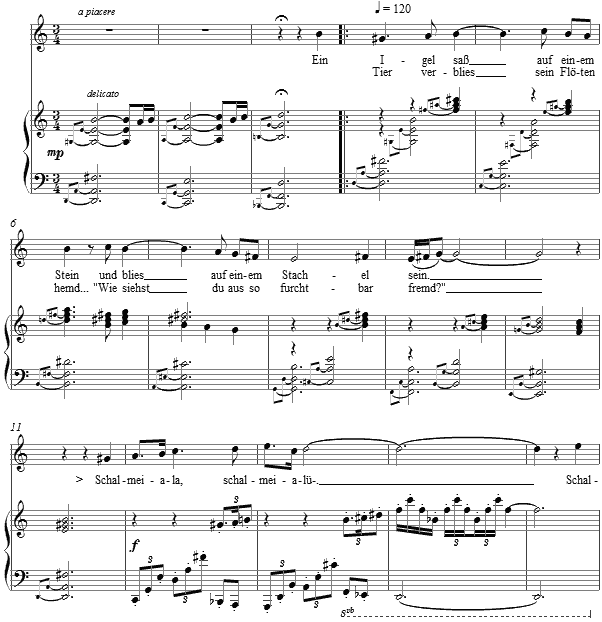Music and Texts of GARY BACHLUND
Vocal Music | Piano | Organ | Chamber Music | Orchestral | Articles and Commentary | Poems and Stories | Miscellany | FAQs
Igel und Agel - (2008)
Christian Morgenstern
for medium voice and piano
Ein Igel saß auf einem Stein
und blies auf einem Stachel sein.
Schalmeiala, schalmeialü!
Da kam sein Feinslieb Agel
und tat ihm schnigel schnagel
zu seinen Melodein.
Schnigula schnagula
schnaguleia lü!
Das Tier verblies sein Flötenhemd...
"Wie siehst du aus so furchtbar fremd!?"
Schalmeiala, schalmeialü -.
Feins Agel ging zum Nachbar, ach!
Den Igel aber hat der Bach
zum Weiher fortgeschwemmt.
Wigula wagula
waguleia wü
tü tü...[ 3 pages, circa 2' 00" ]
Christian Morgenstern
A hedgehog sat on a stone [ 1 ]
and blew on one of his spines.
Shawm-ala, shawm-aloo! [ 2 ]
Then came his sweetie hedge-hag [ 3 ]
and did the "in and out" [ 4 ]
To his merry tune.
In and out and out and in
As that was quite the mood she was in.
The beast blew off his flute-y skin...
"How horrid and strange you look!"
Shawm-ala, shawm-aloo-.
His sweetie hedge-hag went off with the neighbor, oh!
The hedgehog had only the stream
To drown his sorrows away.
Wagalaweia! [ 5 ]
Wallala, weiala weia!
Toot toot....
This strange text tells a tale of love and loss, in puns and silliness. From a tonal beginning, polytonal triads in opposite motion lead the setting away from a more "normal" world of harmony.
The vocal line is accompanied by a falling set of clustered triads in open position. In measure 4, D major underpins E and F sharp majors arpeggiated, leaving the impression of a fixed tonal center unsettled except for the vocal line's seeming center of E. Following measures extend the polytonal argument.
Notated without key signature, the setting comes to a close on C. Nothing in between would lead to this conclusion, however. The arpeggios give way for the little display of virtuosity as the shawm plays a little fanfare. The ending of the setting might be viewed a number of dramaturgical ways, as the hedgehog might "drown his sorrows" with suicide, or perhaps merely end this story forlornly sitting by the passing stream. The bathos of this is up to the performers.
The score for Igel und Agel is available as a free PDF download, though any major commercial performance or recording of the work is prohibited without prior arrangement with the composer. Click on the graphic below for this piano-vocal score.
NOTES
[ 1 ] The hedgehog is "any of several small insectivores (family Erinaceidae) of the Old World, with a shaggy coat and sharp spines on the back, which bristle and form a defense when the animal curls up." One can imagine plucking a spine from its coat, a painful act, in order to serenade his lady love. It quite reminds of the story of Vincent Van Gogh mutilating his ear by similar reason.
[ 2 ] The shawm is a "medieval form of the oboe with a conical bore and flaring bell, blown through a double reed." I had the chance to play one rather inexpertly while an undergraduate at Immaculate Heart College, so many years ago. The college, now disbanded, had a small but fine collection of Renaissance instruments, with which a group of us students formed a consort. As Morgenstern makes his pun, so does this translation refer to the instrument, and its rather piercing tone. The German word, Schalmeientöne, suggests sweet, seductive entreaties honking like an oboe.
[ 3 ] In German, there is no commonly used noun, Agel. Perhaps Morgenstern intends a pun on the adjective, "agil," which means both "agile" and "mentally alert." Depending on a reading of the rest of the comical text, agility might well be suggested, and she -- this "hedge-hag" -- is alert enough to run from the end result of the hedgehog's crazy behavior and subsequent end.
[ 4 ] In one dialect of German, Schnickl is Viennese for the male member, while schnackeln (or the variant, schnackseln) means to make love. To capture this dance, one might use the American dialect's tasty patois, the "in and out." (There is a joke that this is the first of two instructions for making love, the other being "repeat as often as necessary.) While one might also opt for the less imaginative pun on schnacken - to chat -- one imagines the hedge-hag was moved more by the "seductive entreaties" than just to have a chat.
[ 5 ] What might one make of Morgenstern's nonsensical "Wigula wagula / waguleia wü?" Given the high art form of fairy tale nonsense in Wagner's Das Rheingold, the opening lines sung by the Rhine maiden, Woglinde, seem as fine faux translation as one might call up from the world of music, "Wagalaweia! Wallala, weiala weia!" The verb, wogen, means wave, and wiegen to rock; perhaps these were antecedents to Morgenstern's pun?

